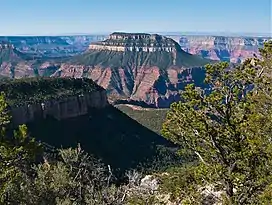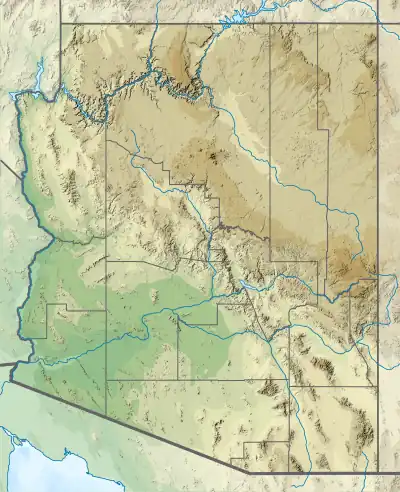Steamboat Mountain (Coconino County, Arizona)
Steamboat Mountain is a 7,410-foot-elevation (2,260-meter) summit located in the Grand Canyon, in Coconino County of northern Arizona, US.[3] It is situated four miles northwest of Holy Grail Temple, and 2.5 miles west-southwest of Timp Point on the North Rim. George Wharton James described it as a "majestic butte", nearly encircled by Galloway and Saddle Canyons.[5] Topographic relief is significant as it rises over 5,400 feet (1,600 meters) above the Colorado River in three miles. According to the Köppen climate classification system, Steamboat Mountain is located in a Cold semi-arid climate zone, with precipitation runoff draining west to the Colorado River via Tapeats Creek and Stone Creek.[6] This feature's name was officially adopted in 1932 by the U.S. Board on Geographic Names.[3]
| Steamboat Mountain | |
|---|---|
 Northeast aspect, from Locust Point | |
| Highest point | |
| Elevation | 7,410 ft (2,260 m)[1] |
| Prominence | 1,370 ft (420 m)[1] |
| Parent peak | Powell Plateau (7,661 ft)[2] |
| Isolation | 2.48 mi (3.99 km)[2] |
| Coordinates | 36°21′57″N 112°23′56″W[3] |
| Geography | |
 Steamboat Mountain Location in Arizona  Steamboat Mountain Steamboat Mountain (the United States) | |
| Location | Grand Canyon National Park Coconino County, Arizona, US |
| Parent range | Kaibab Plateau[1] Colorado Plateau |
| Topo map | USGS Powell Plateau |
| Geology | |
| Type of rock | sandstone, limestone, mudstone |
| Climbing | |
| First ascent | October 17, 1964 Harvey Butchart, Marshall Demick [4] |
History
In 1858, Lieutenant Joseph Ives led an expedition up the Colorado River, starting at the river's mouth and making it to the lower Grand Canyon. The mode of transportation was a steamboat named Explorer. Steamboat Mountain is located in an area of geographical features that were named after the canyon's early explorers. Steamboat Mountain is set at the northern tip of Powell Plateau, named for John Wesley Powell. Ives Point lies six miles to the southwest at the southwest tip of Powell Plateau. Also on Powell Plateau are Newberry Point, Dutton Point, Wheeler Point, Thompson Point, and Beale Point. These Grand Canyon pioneers are collectively commemorated by Explorers Monument, located immediately south of Powell Plateau.[7]
Geology
Steamboat Mountain is composed of Permian Kaibab Limestone, overlaying a conspicuous band of cream-colored, cliff-forming, Permian Coconino Sandstone.[8] The sandstone, which is the third-youngest of the strata in the Grand Canyon, was deposited 265 million years ago as sand dunes. Below the conspicuous Coconino Sandstone layer is slope-forming, Permian Hermit Formation, which in turn overlays the Pennsylvanian-Permian Supai Group.[9] Further down are strata of Mississippian Redwall Limestone, the Cambrian Tonto Group, and finally Paleoproterozoic Vishnu Basement Rocks at river level in Granite Gorge.
Gallery



References
- "Steamboat Mountain, Arizona". Peakbagger.com. Retrieved 2021-01-09.
- "Steamboat Mountain – 7,410' AZ". Lists of John. Retrieved January 9, 2021.
- "Steamboat Mountain". Geographic Names Information System. United States Geological Survey, United States Department of the Interior. Retrieved 2021-01-09.
- Harvey Butchart’s Hiking Log – Detailed Hiking Log (February 28, 1964 – December 31, 1964)
- George Wharton James, The Grand Canyon of Arizona How to See It, 1910, Little Brown and Company, page 83.
- Peel, M. C.; Finlayson, B. L.; McMahon, T. A. (2007). "Updated world map of the Köppen−Geiger climate classification". Hydrol. Earth Syst. Sci. 11. ISSN 1027-5606.
- Randy Moore and Kara Felicia Witt, The Grand Canyon: An Encyclopedia of Geography, History, and Culture, 2018, ABC-CLIO Publisher, page 74.
- N.H. Darton, Story of the Grand Canyon of Arizona, 1917.
- William Kenneth Hamblin, Anatomy of the Grand Canyon: Panoramas of the Canyon's Geology, 2008, Grand Canyon Association Publisher, ISBN 9781934656013.
External links
- Weather forecast: National Weather Service